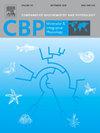肠道长度是否能解释鸟类和哺乳动物的食糜滞留时间?
IF 2.2
3区 生物学
Q4 BIOCHEMISTRY & MOLECULAR BIOLOGY
Comparative Biochemistry and Physiology A-Molecular & Integrative Physiology
Pub Date : 2025-02-01
DOI:10.1016/j.cbpa.2024.111789
引用次数: 0
摘要
先前的研究表明,在鸟类和哺乳动物中,体重是一个相对较差的预测消化物在消化道中保留时间的指标(平均保留时间,MRT)。相反,MRT可能是由胃肠道解剖决定的,这可能在营养行会内部和之间有很大的不同。在这里,我们使用了最近两篇关于鸟类(n = 33种)和哺乳动物(n = 149种)肠道长度和MRT的文献汇编,并应用比较统计学方法来评估肠道长度与MRT的相关性是否比体重更密切。无论使用何种统计模型,无论是否包括小型物种(< 120 g和任何较大的蝙蝠),也无论鸟类和哺乳动物是一起评估还是单独评估,肠道长度通常比体重更适合MRT模型,支持一般概念。然而,数据的分散性很大,表明肠道长度虽然比体重好,但仍然是MRT的一个有限的解释因素。肠道长度- mrt关系是对通常假定的形式-功能关系进行直接统计评估的一个例子,这种关系通常以叙述的形式表示。在比较文献中,这样的评价是罕见的。本文章由计算机程序翻译,如有差异,请以英文原文为准。

Does intestine length explain digesta retention times in birds and mammals?
Previous studies have indicated that across birds and mammals, body mass is a comparatively poor predictor of the time digesta is retained in the digestive tract (mean retention time, MRT). Rather, MRT might be determined by gastrointestinal anatomy, which can differ considerably within and between trophic guilds. Here, we used two recent literature compilations on the intestine length and the MRT in birds (n = 33 species) and mammals (n = 149) and applied comparative statistical approaches to assess whether intestine length is more closely correlated with MRT than body mass. Regardless of the statistical model used, whether small species (< 120 g and any larger bats) were included or not, or whether birds and mammals were assessed together or separately, intestinal length generally yielded a better model fit to MRT than body mass, supporting the general concept. Nevertheless, data scatter was substantial, indicating that intestine length, though better than body mass, is still a limited explanatory factor for MRT. The intestine length-MRT relationship is an example of the direct statistical assessment of a generally presumed form-function relationship that is typically represented as a narrative. In the comparative literature, such assessments are rare.
求助全文
通过发布文献求助,成功后即可免费获取论文全文。
去求助
来源期刊
CiteScore
5.00
自引率
4.30%
发文量
155
审稿时长
3 months
期刊介绍:
Part A: Molecular & Integrative Physiology of Comparative Biochemistry and Physiology. This journal covers molecular, cellular, integrative, and ecological physiology. Topics include bioenergetics, circulation, development, excretion, ion regulation, endocrinology, neurobiology, nutrition, respiration, and thermal biology. Study on regulatory mechanisms at any level of organization such as signal transduction and cellular interaction and control of behavior are also published.

 求助内容:
求助内容: 应助结果提醒方式:
应助结果提醒方式:


